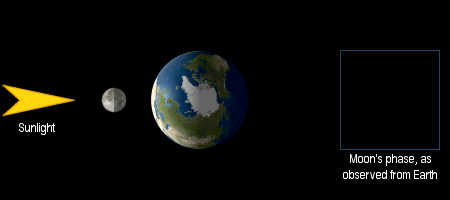The Moon
Neither Mercury nor Venus possess natural satellites of their own, so the Earth is the first body (from the Sun) to possess one. The same hemisphere of the Moon always faces the Earth. Until the beginning of the space age no one had seen the far side, which was first imaged by the Russian probe Luna 3 on 7th October 1959.

The Moon is the second largest natural satellite relative to the parent planet in the Solar System, and its very presence may have induced regularity in the rotation of the Earth and aided the evolution of life upon it. The table below provides some information on the Moon, including orbital characteristics (Illingworth, 1994).
| Satellite | Diameter (Km) |
Orbital Radius (Km) |
Eccentricity | Orbital Period (days) |
Inclination (°) |
|---|---|---|---|---|---|
| The Moon | 3 476 | 384 400 | 0.055 | 27.32 | 23.4 |
Phases of the Moon
The animation below (not to scale; looking down on the north pole) illustrates the Moon's motion around the Earth relative to the Sun, explaining its phases as observed on Earth.

Formation
The formation of the Moon has been a point of debate for many years in the astronomical community, but the most convincing and generally accepted theory is that a large Mars-sized body collided with a primieval Earth soon after it was formed, throwing a huge cloud of debris into orbit around the Earth. Over several millions of years, it collected together and became the Moon.
Geological History
The following table shows the lunar stratigraphic timescale, in which the times shown are in billions of years before the present (Ga). It also shows the main events of each eon. (Sources: Greeley, 1994; Illingworth, 1994)
| Time (Ga) | Eon | Events |
|---|---|---|
| 1.00 - 0.00 | Copernican | |
| 3.15 - 1.00 | Eratosthenian | |
| 3.85 - 3.15 | Imbrian | |
| 3.92 - 3.85 | Nectarian | |
| 4.57 - 3.92 | Pre-Nectarian | |
Missions to the Moon
For a list of missions to the Moon see the links page.

[ NASA / JPL / Caltech ]